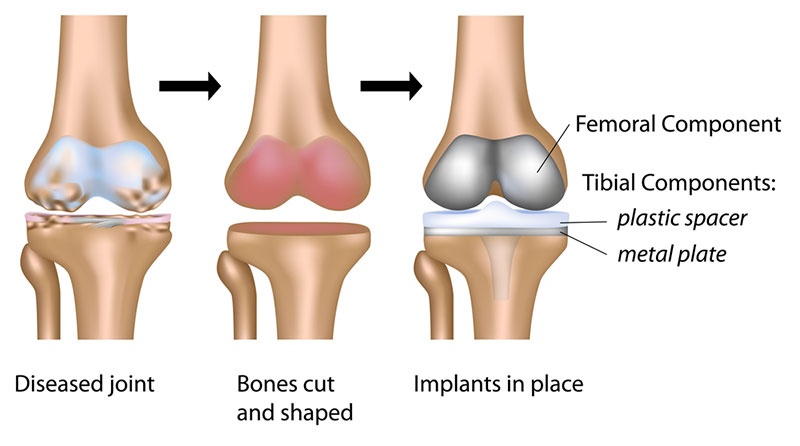Total Knee Replacement
LOADING
When a knee develops end-stage arthritis, it may develop significant pain, initially during, or not long after weight-bearing activity such as walking, kneeling or squatting. In some instances certain regions of the knee are painful after holding the knee in a prolonged position (e.g. after sitting through a feature length movie). The pain is due to the grinding of the raw bone ends into each other once they have lost their smooth cartilage covering and lubricating fluid. This is accentuated as the knee is loaded down with body weight, heavy force or strenuous muscle activity. Eventually the pain may go on to become present at night time, and this may be due to the release of inflammatory chemicals into the knee joint due to the breakdown of tissue.
Other symptoms may include progressive deformity (knock knees or bow legs), stiffness, swelling, limping or a sensation of grating or crunching from within the knee.
Other symptoms may include progressive deformity (knock knees or bow legs), stiffness, swelling, limping or a sensation of grating or crunching from within the knee.

Total Knee Replacement
Non-operative Treatment Prior to Total Knee Replacement
Generally, Mr Robin will advocate a course of non-operative treatment before advising surgery. This will usually include trying simple analgesics such as paracetamol (e.g. Panadol Osteo), anti-inflammatories (e.g. Mobic, Voltaren, Naprosyn or Celebrex), physiotherapy and hydrotherapy to improve or maintain the flexibility, muscle strength and co-ordination of the knee. Some patients may be willing to use a walking stick to help offload the arthritic knee, although this is less common in the 21st century.
When is the Right Time to Have My Knee Replaced?
In general, when you find that your symptoms are intrusive in your day-to-day life, despite having tried all the above non-operative treatments, then this is usually a good guide as to when you may want to consider Total Knee Replacement. This may include uncontrollable pain despite using analgesics and anti-inflammatories, significant disturbance of sleep, reduced walking distance or endurance, or if there is a progressive deformity or substantial stiffness of the knee such that day-to-day activities such as managing stairs, putting on shoes/socks/pantyhose is a major effort.
What is a Total Knee Replacement?
Total Knee Replacement is an orthopaedic operation, the aim of which is to remove the arthritic surfaces of the distal femur and proximal tibia (and sometimes the patella) and to replace them with a (usually) metallic cap that bonds to the distal femur and a metallic tray that bonds to the proximal tibia. The tibial tray has a polyethylene liner which firmly clips in to the tray to lock it in place. This metal and plastic “sandwich” readily allows flexion and extension of the knee, and a smaller amount of translation and rotation, similar (but not always identical) to the mechanics of the natural knee. In removing the arthritic surfaces, the painful stimuli are removed, restoring range of movement. During the procedure the anterior cruciate ligament is routinely removed, but the posterior cruciate may be removed or retained, depending on the design of the knee replacement. The collateral ligaments are preserved, but frequently they need to be loosened from their attachment to the tibia to help straighten the knee joint and permit more movement of the knee.
Mr Robin uses an LIA technique infiltrating a local anaesthetic cocktail into the tissues of the knee to reduce post-operative pain, and usually he leaves a fine catheter to drip-feed further local anaesthetic into the knee for the first post-operative day. Please see the section on Early Mobilisation for post-operative protocol.
Why Shouldn’t I Have My Knee Replacement Straight Away?
While total knee replacement is an excellent operation with regards to pain relief in over 80% of patients, large studies have shown that up to 20% of patients may still be “dis-satisfied” with the results of their knee replacement. In contrast, total hip replacement satisfaction rates are closer to 90-95%. The reasons for this are not clear, despite having had an technically well done operation, although it may have a lot to do with the multiple complex movements that a knee replacement is required to cope with and the new stresses applied to the tissues surrounding the replaced knee. Much like a total hip replacement, a total knee replacement can be thought of as a non-user-serviceable piece of machinery. As such, it has a finite lifespan, as any piece of machinery with moving parts can fail. Add to this the complex element of human biology and variable levels of activity and it starts to become difficult to give a clear estimate of how long a knee replacement will last in any one patient. When a knee replacement fails to function satisfactorily, then it may require a revision knee replacement. Each time a knee is revised there is loss of bone and the results become somewhat less predictable and possibly less durable than the initial total knee replacement. Moreover, the younger or more active the patient is at the time of their total knee replacement, the shorter the anticipated lifespan of the prosthesis, due to the amount of cycles the knee may be required to do.
The information above is general. All surgical procedures involve some risk. If you would like advice on your specific condition, please contact the office of Mr Daniel Robin, Melbourne Orthopaedic Surgeon.

